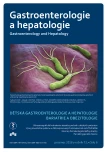Intrapancreatic accessory spleen as a rare solid pancreatic lesion
Authors:
Krlínová I. 1; Shon F. 1; Štiková Z. 2; Maxa V. 3; Mareš L. 4; Šabata L. 3
Authors‘ workplace:
Gastroenterologické oddělení, Nemocnice České Budějovice, a. s.
1; Patologické oddělení, Nemocnice České Budějovice, a. s.
2; Oddělení nukleární medicíny, Nemocnice České Budějovice, a. s.
3; Radiologické oddělení, Nemocnice České Budějovice, a. s.
4
Published in:
Gastroent Hepatol 2018; 72(6): 522-526
Category:
doi:
https://doi.org/10.14735/amgh2018522
Overview
The incidence of solid pancreatic lesions (SPL) is currently increasing as a result of the increasing number of imaging examinations. It is often an incidental finding. A special case of SPL is an intrapancreatic accessory spleen (IPAS). We present a rare IPAS finding in two case reports. The first case is a 62-year-old man with diagnosed early cancer of the ascending colon, in whom primary IPAS diagnosis was based on a postoperative histopathological examination. The second case is a 50-year-old woman with a renal cyst, in whom IPAS diagnosis was based on the imaging findings obtained using Technetium-99m scintigraphy (Tc-99m SPECT). Because IPAS is a benign lesion of the pancreas, diagnosis using functional imaging of splenic tissue (Tc-99m Heat-damaged Red Blood Cell scintigraphy, contrast-enhanced ultrasonography using microgranules and superparamagnetic iron oxide (SPIO)-enhanced magnetic resonance imaging), as well as other diagnostic modalities, is the preferred option. Another method of diagnosis is endoscopic ultrasound guided fine needle aspiration. However, the diagnosis of this lesion is still difficult. A significant number of SPLs are potentially malignant; therefore, most cases are indicated for surgical resection, in which case IPAS diagnosis is based on postoperative histopathological examination.
Key words:
intrapancreatic accessory spleen – differential diagnosis – pancreatic neoplasms
Submitted: 23. 4. 2018
Accepted: 12. 5. 2018
The authors declare they have no potential conflicts of interest concerning drugs, products, or services used in the study.
The Editorial Board declares that the manuscript met the ICMJE „uniform requirements“ for biomedical papers.
Sources
1. Trna J, Kala Z. Klinická pankreatologie. Praha: Mladá fronta 2016 : 239– 241.
2. Halpert B, Gyorkey F. Lesions observed in accessory spleens of 311 patients. Am J Clin Pathol 1959; 32(2): 165– 168.
3. Meyer-Rochow GY, Gifford AJ, Samra JS et al. Intrapancreatic splenunculus. Am J Surg 2007; 194(1): 75– 76.
4. Touré L, Bédard J, Sawan B et al. Case note: intrapancreatic accessory spleen mimicking a pancreatic endocrine tumour. Can J Surg 2010; 53(1): E1– E2.
5. Meiler R, Dietl KH, Novák K et al. Intrapancreatic accessory spleen. Int Surg 2010; 95(2): 183– 187.
6. Katuchova J, Baumohlova H, Harbulak P et al. Intrapancreatic accessory spleen. A case report and review of literature. JOP 2013; 14(3): 261– 263. doi: 10.6092/ 1590-8577/ 1231.
7. Zeman M, Zembala-Nożyńska E, Sczasny J et al. Intrapancreatic accessory spleen imitating a pancreatic neoplasm. Pol Przegl Chir 2011; 83(10): 568– 570. doi: 10.2478/ v10035-011-0090-9.
8. Ota T, Tei M, Yoshioka A et al. Intrapancreatic accessory spleen diagnosed by technetium-99m heat-damaged red blood cell SPECT. J Nucl Med 1997; 38(3): 494– 495.
9. Kim SH, Lee JM, Han JK et al. Intrapancreatic accessory spleen: findings on MR imaging, CT, US and scintigraphy, and the pathologic analy-sis. Korean J Radiol 2008; 9(2): 162– 174. doi: 10.3348/ kjr.2008.9.2.162.
10. Ota T, Ono S. Intrapancreatic accessory spleen: diagnosis using contrast enhanced ultrasound. Br J Radiol 2004; 77(914): 148– 149.
11. Kim SH, Lee JM, Han JK et al. MDCT and superparamagnetic iron oxide (SPIO) – enhanced MR findings of intrapancreatic accessory spleen in seven patients. Eur Radiol 2006; 16(9): 1887– 1897.
12. Kim SH, Lee JM, Lee JY et al. Contrast-enhanced sonography of intrapancreatic accessory spleen in six patients. AJR Am J Roentgenol 2007; 188(2): 422– 428.
13. Lin J, Jing X. Fine-needle aspiration of intrapancreatic accessory spleen, mimic of pancreatic neoplasms. Arch Pathol Lab Med 2010; 134(10): 1474– 1478. doi: 10.1043/ 2010-0238-CR.1.
14. Ardengh JC, Lopes CV, Kemp R et al. Pancreatic splenosis mimicking neuroendocrine tumors: microhistological diagnosis by endoscopic ultrasound guided fine needle aspiration. Arq Gastroenterol 2013; 50(1): 10– 14.
Labels
Paediatric gastroenterology Gastroenterology and hepatology SurgeryArticle was published in
Gastroenterology and Hepatology

2018 Issue 6
- Metamizole at a Glance and in Practice – Effective Non-Opioid Analgesic for All Ages
- Metamizole vs. Tramadol in Postoperative Analgesia
- The Importance of Limosilactobacillus reuteri in Administration to Diabetics with Gingivitis
- Safety and Tolerance of Metamizole in Postoperative Analgesia in Children
Most read in this issue
- Meckel’s diverticulum as a cause of abdominal emergency
- Hepatopathy as the first manifestation of systemic AL amyloidosis
- Wilson’s disease in childhood – two case reports
- News of pharmacological treatment of obesity
